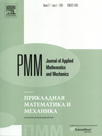 | | Journal of Applied
Mathematics and Mechanics
Russian Academy of Sciences | | Founded
in January 1936
(Translated from 1958)
Issued 6 times a year
ISSN 0021-8928
(print version) |
Archive of Issues
| Total articles in the database: | | 10610 |
| In Russian (¤╠╠): | | 9811
|
| In English (J. Appl. Math. Mech.): | | 799 |
|
| << Previous article | Volume 77, Issue 6 / 2013 | Next article >> |
| V.N. Tkhai, "A mechanical system containing weakly coupled subsystems," J. Appl. Math. Mech. 77 (6), 588-594 (2013) |
| Year |
2013 |
Volume |
77 |
Issue |
6 |
Pages |
588-594 |
| Title |
A mechanical system containing weakly coupled subsystems |
| Author(s) |
V.N. Tkhai (Moscow, Russia, tkhaivn@yandex.ru) |
| Abstract |
The concept of a mechanical system (model), containing coupled subsystems (MSCCS) is introduced. Examples of such a system are the Sunľplanetsľsatellites system, a system of interacting moving objects, a system of translationally and rotationally moving celestial bodies, chains of coupled oscillators, Sommerfeld pendulums, spring systems, etc. The MSCCS subsystems and the entire system are analysed, and problems related to the investigation of the oscillations, bifurcation, stability, stabilization and resonance are stated. A solution of the oscillations problem is given for a class of MSCCS, described by reversible mechanical systems. It is proved that the autonomous MSCCS retains its family of symmetrical periodic motions (SPMs) under parametric perturbations, while in the periodic MSCCS a family of SPMs bifurcates by producing two families of SPMs. The two-body problem and the N-planet problem are investigated as applications. The generating properties of the two-body problem are established. For the N-planet problem it is proved that an (N+1)-parametric family of orbits exists, close to elliptic orbits of arbitrary eccentricity, the family being parametrized by energy integral constant, and a syzygy of planets occurs. |
| Received |
25 October 2012 |
| Link to Fulltext |
|
| << Previous article | Volume 77, Issue 6 / 2013 | Next article >> |
|
 If you find a misprint on a webpage, please help us correct it promptly - just highlight and press Ctrl+Enter If you find a misprint on a webpage, please help us correct it promptly - just highlight and press Ctrl+Enter
|
|

 Russian
Russian  English
English